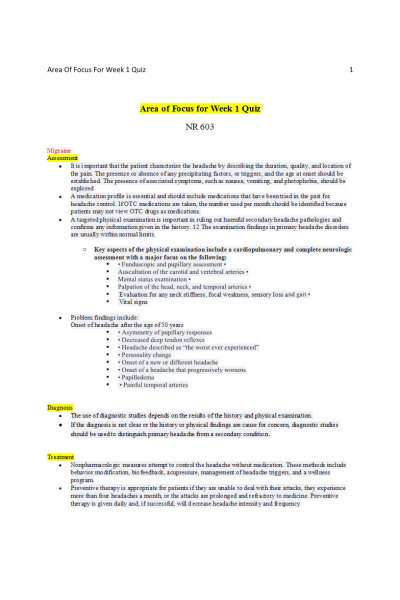NR 603 Week 1 Quiz; Area of Focus
-
$15.00
| Institution | NR 603 Advanced Clinical Diagnosis and Practice Across the Lifespan |
| Contributor | Sharonda |
Preview of Starting Page…..
Migraine
Assessment
- It is important that the patient characterize the headache by describing the duration, quality, and location of the pain. The presence or absence of any precipitating factors, or triggers, and the age at onset should be established. The presence of associated symptoms, such as nausea, vomiting, and photophobia, should be explored
- A medication profile is essential and should include medications that have been tried in the past for headache control. If OTC medications are taken, the number used per month should be identified because patients may not view OTC drugs as medications.
- A targeted physical examination is important in ruling out harmful secondary headache pathologies and confirms any information given in the history. 12 The examination findings in primary headache disorders are usually within normal limits.
- Key aspects of the physical examination include a cardiopulmonary and complete neurologic assessment with a major focus on the following:
- • Funduscopic and pupillary assessment •
- Auscultation of the carotid and vertebral arteries •
- Mental status examination •
- Palpation of the head, neck, and temporal arteries •
- Evaluation for any neck stiffness, focal weakness, sensory loss and gait •
- Vital signs
- Problem findings include:
Onset of headache after the age of 50 years- • Asymmetry of pupillary responses
- • Decreased deep tendon reflexes
- • Headache described as “the worst ever experienced”
- • Personality change
- • Onset of a new or different headache
- • Onset of a headache that progressively worsens
- • Papilledema
- • Painful temporal arteries
Preview of Last Page…..
Treatment
- First priority for patient with traumatic head injury: Manage circulation, airway, breathing, and cervical spine. • Second priority: Correct hypoxia with 100 % high flow oxygen (in adults, PaO 2 <60 mm Hg) and hypotension (in adults, systolic blood pressure <90 mm Hg) because of associated morbidity and mortality. 11 • Third priority: Assess primary injury and rapidly recognize surgically correctable lesion. • Further evaluation for evidence of lacerations and other trauma (e.g. depressed skull fracture) is necessary.
End of Document Preview
| Instituition / Term | |
| Term | Fall 2020 |
| Institution | NR 603 Advanced Clinical Diagnosis and Practice Across the Lifespan |
| Contributor | Sharonda |












